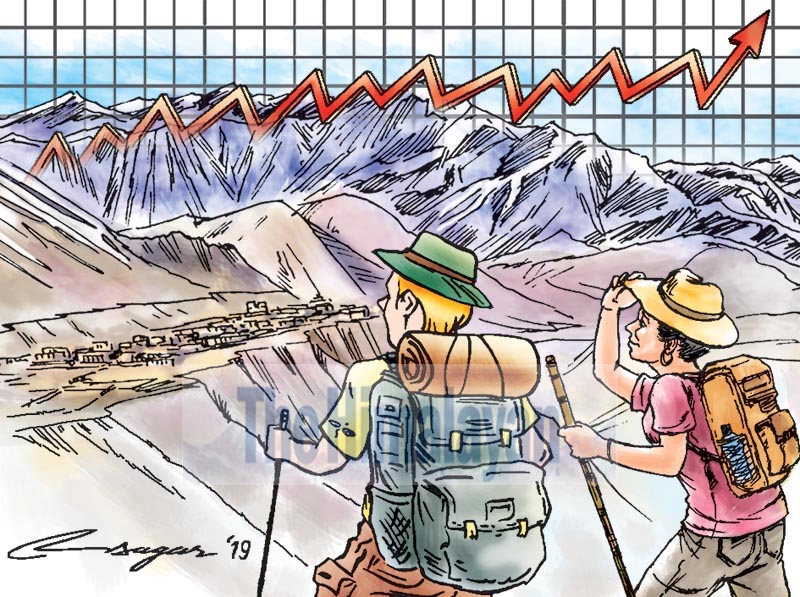Tourism industry in Nepal: Make it backbone of economy
Spain maintains first place globally in the global travel and tourism competitiveness index. The 2017 report covers 136 economies, of which China ranks 15th, India 40th and Nepal 103rd in global rankings
As one of the world’s largest economic sectors, travel and tourism creates jobs, drives exports, and generates prosperity across the world. So it continues to make a real difference to the lives of millions of people by driving growth, reducing poverty and fostering development.According to the World Travel & Tourism Council’s (WTTC) annual research in 2018, travel and tourism is one of the world’s booming industries, generating approximately US$ 8.8 trillion annually and contributing 319 million jobs to the world economy.
Similarly, over 600 million international tourists visit different parts of the world every year.
Tourism has become one of the main income sources for many developing countries like Nepal. Nepal has great potential to become a top destination for tourists as the nation is famous for its snowcapped mountains, abundant flora and fauna, exciting trekking routes and rich cultural and religious diversity.
According to Lonely Planet, Kathmandu is the 5th top travel destination while tripadvisor.com has ranked Kathmandu at 19th out of 25 best tourism destinations in the world for the year 2019. These facts reveal that there are many places like Kathmandu that could fascinate tourists from around the world.
According to the WTTC, the share of the travel and tourism sector in India’s GDP is about 10 per cent. It is about 5 per cent in Nepal. Spain maintains first place globally in the global travel and tourism competitiveness index. The 2017 report covers 136 economies, of which China ranks 15th, India 40th and Nepal 103rd in global rankings.
In order to promote the country’s tourism industry, the government has announced the ‘Visit Nepal 2020’ campaign with the aim of bringing in two million tourists by 2020. In recent years, the country’s tourism industry has witnessed positive signals along with the increase in the inflow of foreign tourists after being badly hit by the devastating earthquake of 2015. According to the Economic Survey of 2018/19, the number of tourist arrivals in 2018, not counting Indian tourists who arrived by land, was 1,173,072, which is 25 per cent more than in 2017.
While analysing the total number of tourist arrivals by country, the top five tourist generating countries are India, China, USA, UK and Sri Lanka respectively, making up nearly half of all tourist arrivals. The tourism industry raked in foreign currency equivalent to Rs 76.09 billion in 2017/18. Of the total number of tourists visiting Nepal in 2018 by purpose, more than a two-thirds of them arrived for vacation, entertainment or travel. Of which, entertainment made up 60 per cent, mountaineering/trekking 16 per cent, religious tours 14.4 per cent and others 9.6 per cent.
In addition to foreign tourists, there is an increasing trend of internal tourists visiting different parts of Nepal. Given the growing commotion of people, lured by the natural, cultural, historical, and ethnic diversity, Nepal is capable of transforming the overall socio-economic status of the country. Some of the major tourism activities in Nepal are mountain climbing, trekking, paragliding, rafting, bungee jumping, mountain flight, rock climbing, mountain biking, jungle safari, rock climbing, bird watching and sightseeing. Hence, use of local products and skills play a pivotal role in promoting tourism that can lead to economic prosperity of the country.
Nepal holds great potential for tourism development, which can stimulate economic growth and development. For Nepal, tourism is the main instrument for regional development with positive economic impact on the income, employment and production. In recent years, there has been exponential growth in the number of travel agencies, tour guides, tour operators, rafting agencies and trekking agencies. In 2018, the number of registered travel agencies reached up to 3,508 and trekking agencies 2,649. However, tourism may also have a negative impact on the environment. For sustainable tourism development, there should be optimum utilisation of natural resources and minimisation of ecological, cultural and social impacts. Additionally, there is a need for conducive policies and strategies by the government that will help improve the livelihood of the local communities through balanced and sectoral tourism development.
The government has formulated policies and allocated a budget of Rs 2.68 billion for FY 2019/20 to support the tourism sector in developing infrastructure and encouraging environment -friendly tourism activities. Additionally, the government has allocated Rs 15.85 billion to the aviation sector for the development of domestic and international tourism sector.
Many research studies conducted worldwide show that tourism development spurs economic growth. This calls for collective efforts and collaboration among all the stakeholders in formulating amicable policies and strategies to develop the sector that will contribute in achieving higher economic growth, i.e., 8.5 per cent as envisioned by the government.
Herculean efforts are needed from all the stakeholders to reform and develop the travel and tourism sector in an integrated manner to compete with other tourist destinations of the world through rapid investment, effective campaigning and branding.
Mahatara is assistant director, Nepal Rastra Bank






